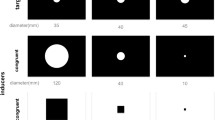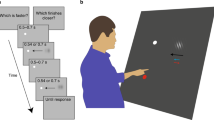Abstract
Recent empirical research has revealed differences in functional capacity between the upper and lower visual fields (VFs), with the lower VF exhibiting superiority in visual perception skills. Similarly, functional differences between the left and right hemispheres elicit a predominance for visuospatial processing in the left visual field (left VF). Both anatomical as well as evolutionary arguments have been adopted in accounting for these variations in function. Preceding upper and lower VF research has typically investigated either static stimulus perception or the visual processing of upper limb action. The aim of the current research was to investigate whether the lower VF benefits associated with limb control transcend to visual anticipation (the perception of motion). Methods were based on Khan and Lawrence (Exp Brain Res 164:395–398, 2005), who investigated upper/lower VF differences in visuomotor control, but utilising a representational momentum paradigm to isolate perceptual processes. Thirty-two participants were randomised into either a left or right VF group and completed a perceptual computer-based task in the upper and lower VF, where they were required to judge the final position of a moving object before it disappeared. Two aspects of the distributions of same responses were then analysed; the central tendency (weighted means) and the variability. Results revealed that in the left VF, weighted means for the lower VF were significantly greater than for the upper VF [t(14) = 2.242, p = 0.042]. In both left and right VFs, variability was greater in the upper compared to lower VF. This provides new findings regarding visual processes in the different visual fields. While visual search and large scene perception has been found to be superior in the upper VF, here we find that visual anticipation, like target-directed visuomotor skill, is superior in the lower VF.


Similar content being viewed by others
Notes
To verify these vertical and horizontal eye positions, participants viewed the fixation point through the 8-mm-diameter circular bore of a cylinder (25 mm diameter; 32 mm length) that was placed perpendicular against the monitor screen; adjustments to the chin/head rest were made until the fixation point appeared to the participant to be centred in the cylindrical bore.
Hayes and Freyd (2002) have demonstrated in an RM paradigm that precision of responses about the central tendency decreases under dual task conditions. Other perceptual judgments, such as of colour, orientation, and static location, also become less precise under dual task conditions (e.g. Prinzmetal et al. 1998). It might be expected, then, that any differences in attentional deployment to the upper versus lower visual fields might be reflected in changes in the variability of the distributions of same responses.
References
Berry MJ Jr, Brivanlou IH, Jordan TA, Meister M (1999) Anticipation of moving stimuli by the retina. Nature 398:334–338
Blättler C, Ferrari V, Didierjean A, Elslande P, Marmèche E (2010) Can expertise modulate representational momentum? Vis Cognit 18(9):1253–1273
Carlsen AN, Maslovat D, Chua R, Franks IM (2007) Perceptual processing time differences owing to visual field asymmetries. Neuroreport Vis 18(10):1067–1070
Curcio CA, Allen KA (1990) Topography of ganglion cells in human retina. J Comparative Neurol 300:5–25
Curcio CA, Sloan KR, Packer O, Hendrickson AE, Kalina RE (1987) Distribution of cones in human and monkey retina: individual variability and radial asymmetry. Science 236:579–581
Danckert J, Goodale M (2001) Superior performance for visually guided pointing in the lower visual field. Exp Brain Res 137:303–308
Danckert J, Goodale M (2003) Ups and downs in the visual control of action. In: Johnson-Frey SH (ed) Taking action: cognitive neuroscience perspectives on intentional actions. MIT Press, Cambridge, Mass, pp 29–64
Efron R, Yund E, Nichols D (1990) Detectability as function of target location: effects of spatial configuration. Brain Cognit 12:102–116
Fecteau JH, Enns JT, Kingstone A (2000) Competition-induced visual field differences in search. Psychol Sci 11(5):386–393
Felleman DJ, Van Essen DC (1991) Distributed hierarchical processing in the primate cerebral cortex. Cereb Cortex 1:1–47
Finke RA, Freyd JJ, Shyi GCW (1986) Implied velocity and acceleration induce transformations of visual memory. J Exp Psychol Gen 115:175–188
Freyd JJ, Finke RA (1984) Representational momentum. J Exp Psychol Learn Mem Cogn 10:126–132
Freyd JJ, Finke RA (1985) A velocity effect for representational momentum. Bull Psychon Soc 23(6):443–446
Freyd JJ, Jones KT (1994) Representational momentum for a spiral path. J Exp Psychol Learn Mem Cogn 20(4):968–976
Freyd JJ, Pantzer TM (1995) Static patterns moving in the mind. In: Smith SM, Ward TB, Finke RA (eds) The creative cognition approach. MIT Press, Cambridge, MA, pp 181–204
Freyd JJ, Pantzer TM, Chang JL (1988) Representing statics as forces in equilibrium. J Exp Psychol Gen 117:395–407
Galati G, Lobel E, Vallar G, Berthoz A, Pizzamiglio L, Le Bihan D (2000) The neural basis of egocentric and allocentric coding of space in humans: a functional magnetic resonance study. Exp Brain Res 133:156–164
Goodale MA, Milner AD (1992) Separate visual pathways for perception and action. Trends Neurosci 15(1):20–25
Halpern AR, Kelly MH (1993) Memory biases in left versus right implied motion. J Exp Psychol Learn Mem Cogn 19:471–484
Hayes AE, Freyd JJ (2002) Representational momentum when attention is divided. Vis Cognit 9:8–27
Heilman KM, Ven Den Abell T (1980) Right hemisphere dominance for attention. Neurology 30(3):327
Hubbard TL (2005) Representational momentum and related displacements in spatial memory: a review of the findings. Psychon Bull Rev 12(5):822–851
Hubbard TL, Bharucha JJ (1988) Judged displacement in apparent vertical and horizontal motion. Percept Psychophys 44:211–221
Hudson M, Burnett HG, Jellema T (2012) Anticipation of action intentions in autism spectrum disorder. J Autism Dev Disord 42:1684–1693
Keppel G (1991) Design and analysis: a researcher’s handbook, 3rd edn. Prentice Hall, Upper Saddle River, NJ
Khan MA, Lawrence GP (2005) Differences in visuomotor control between the upper and lower visual fields. Exp Brain Res 164:395–398
Khurana B, Nijhawan R (1995) Extrapolation or attention shift? Nature 378:565–566
Krigolson O, Heath M (2006) A lower visual field advantage for endpoint stability but no advantage for online movement precision. Exp Brain Res 170:127–135
Lee B, Kaneoke Y, Kakigi R, Sakai Y (2009) Human brain response to visual stimulus between lower/upper visual fields and cerebral hemispheres. Int J Psychophysiol 74:81–87
Lennie P (1981) The physiological basis of variations in visual latency. Vis Res 21:815–824
Piotrowski AS, Jakobson LS (2011) Representational momentum in older adults. Brain Cogn 77:106–112
Previc F (1990) Functional specialization in the lower and upper visual fields in humans: its ecological origins and neurophysiological implications. Behav Brain Sci 13:519–575
Previc F, Blume J (1993) Visual search asymmetries in three-dimensional space. Vis Res 33:2697–2704
Prinzmetal W, Wilson A (1997) The effect of attention on phenomenal length. Perception 26(2):193–205
Prinzmetal W, Amiri H, Allen K, Edwards T (1998) Phenomenology of attention: 1. color, location, orientation, and spatial frequency. J Exp Psychol Hum Percept Perform 24(1):261–282
Reed CL, Vinson NG (1996) Conceptual effects on representational momentum. J Exp Psychol Hum Percept Perform 22(4):839–850
Rubin N, Nakayama K, Shapley R (1996) Enhanced perception of illusory contours in the lower versus upper visual hemifields. Science 271(5249):651–653
Shepard RN (1981) Phsychophysical complementarity. In: Kubovy M, Pomerantz JR (eds) Perceptual organisation. Erlbaum, Hillsdale, NJ, pp 279–341
Taylor NM, Jakobson LS (2010) Representational momentum in children born preterm and at term. Brain Cogn 72:464–471
Thornton IM, Hayes AE (2004) Anticipating action in complex scenes. Vis Cognit 11:341–370
Thorpe S, Fize D, Marlot C (1996) Speed of processing in the human visual system. Nature 381:520–522
Verfaillie K, d’Ydewalle G (1991) Representational momentum and event course anticipation in the perception of implied periodical motions. J Exp Psychol Learn Mem Cogn 17(2):302–313
Vinson N, Reed CL (2002) Sources of object-specific effects in representational momentum. Visual Cognit 9(1/2):41–65
White H, Minor SW, Merrell J, Smith T (1993) Representational-momentum effects in the cerebral hemispheres. Brain Cogn 22(2):161–170
Author information
Authors and Affiliations
Corresponding author
Rights and permissions
About this article
Cite this article
Gottwald, V.M., Lawrence, G.P., Hayes, A.E. et al. Representational momentum reveals visual anticipation differences in the upper and lower visual fields. Exp Brain Res 233, 2249–2256 (2015). https://doi.org/10.1007/s00221-015-4294-9
Received:
Accepted:
Published:
Issue Date:
DOI: https://doi.org/10.1007/s00221-015-4294-9




